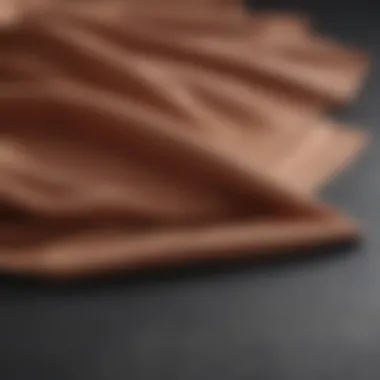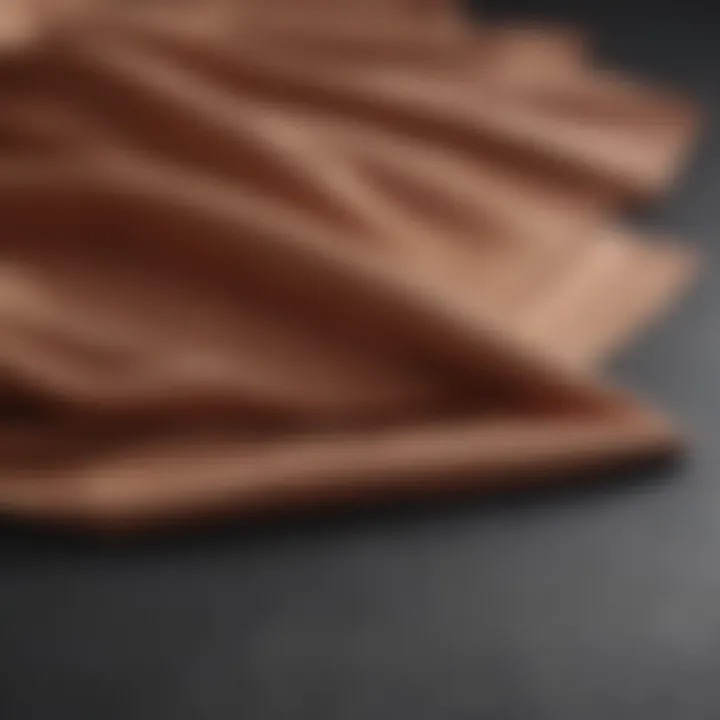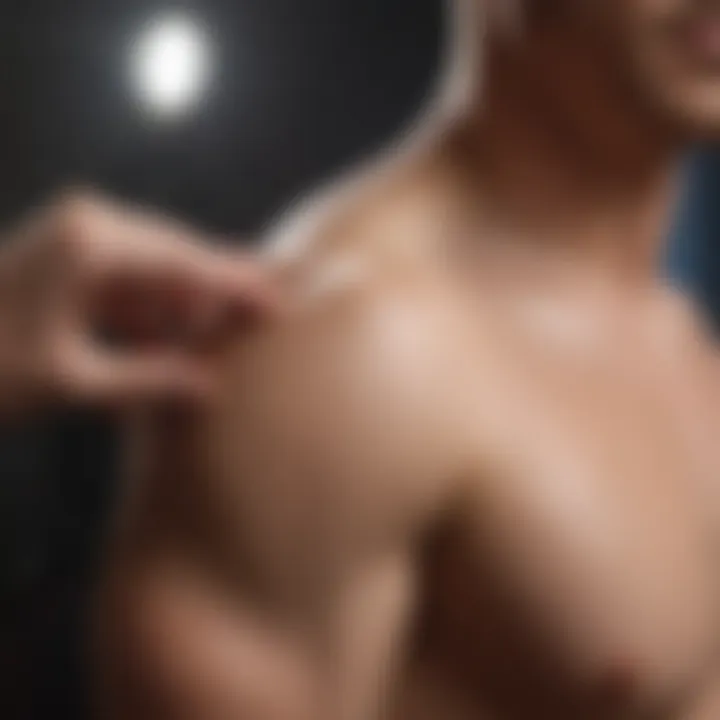Effective Strategies for Preventing and Managing Chafing


Intro
Chafing affects many people who engage in sports or physical activity. It happens when skin or clothing rubs together, causing irritation. Understanding chafing's causes can help in identifying effective prevention and management methods. This guide presents a thorough review of effective strategies, materials, and products to reduce the risk of experiencing chafing.
Understanding Chafing
What Is Chafing?
Chafing is a skin irritation caused by friction. This friction typically occurs in areas where skin rubs against itself or clothing, often during movement. Areas like the inner thighs, armpits, and nipples are common spots for chafing. When these areas are subjected to repetitive motion and lack protection, discomfort arises, potentially leading to inflammation or even skin sores.
Who Is Affected?
Anyone who participates in physical activity can be affected by chafing. Runners, cyclists, and athletes are among the most commonly affected. However, even casual walkers or individuals engaging in daily routines can experience this discomfort.
Prevention Techniques
Material Choices
Choosing the right materials is critical to prevent chafing. Opt for moisture-wicking fabrics such as polyester or blends specifically designed for sportswear. These materials help keep skin cool and dry, minimizing friction.
Proper Fit
Wearing well-fitted clothing can reduce the risk of chafing. This applies to not overly tight or loose garments, both of which can exacerbate friction. Quality seams also play a role; flat seams create less likelihood of skin irritation.
Protective Products
One effective way to manage chafing is by applying protective barriers on the skin. Some useful products include:
- Anti-Chafe Creams: These create a protective coating on skin that decreases friction. Brands like Body Glide or Chamois Butt'r are popular among athletes.
- Body Powder: Talcum substances can help absorb moisture. It’s advisable to apply sparingly in vulnerable areas.
- Bandages or Patches: Specialized patches offer localized protection where chafing occurs often, ensuring comfort.
Practical Tips for Managing Chafing
Hydration
Keeping the body hydrated helps in reducing sweat, which is a contributing factor to chafing. Drinking adequate amounts of water can help maintain skin integrity.
Frequent Breaks during Activities
Taking breaks during prolonged activities can help ease pressure on areas prone to chafing. Short rests allow skin to be less stressed.
Assess and Adapt
It is beneficial to take time to assess one's activity routine. Noting adjustments in clothing or habits can inform better choices moving forward. If discomfort arises, acknowledging and adapting habits promptly can prevent escalation.
Finale
Chafing can be a damaging factor to anyone engaged in any physical activity. Taking control and implementing preventive measures can enhance comfort and maintain overall wellbeing. Through the right choices in clothing, materials, and protective products, one can confidently engage in sports or any daily activities, knowing that discomfort from chafing can be effectively managed.
Understanding Chafing
Chafing is a common occurrence for anyone engaging in physical activities or daily routines where skin rubs against skin or clothing. It is important to understand chafing to find effective solutions and prevent discomfort or injury. Knowing what causes chafing enables individuals to take practical measures to reduce the likelihood of experiencing it. Recognition of areas most vulnerable to chafing can also guide appropriate clothing choices and care routines, which ultimately improves overall well-being and comfort.
Definition of Chafing
Chafing refers to skin irritation resulting from friction. This friction causes redness, swelling, and even pain in the affected areas. Many people experience it on body parts such as the inner thighs, armpits, and beneath the breasts. Understanding the dry skin, dampness and different body types adds another layer to effectively tackling this issue.
Causes of Chafing
Chafing primarily occurs due to repeated friction. This friction can happen when clothing rubs against the skin, especially during movements like running or walking. Other contributing factors include:
- Moisture: Sweat or other fluids can exacerbate friction, leading to swelling.
- Heat: High temperatures can increase sweating and make the skin more susceptible to chafing.
- Improper Fit of Clothing: Clothing that is too tight or too loose can create unwanted friction against the skin.
- Skin Sensitivity: Some individuals have more sensitive skin, leading to an increased risk of irritation.
Understanding these causes leads to better preventive strategies and more informed care.
Common Areas Affected
Chafing affects various regions of the body where skin-to-skin or skin-to-cloth contact happens. Common areas include:
- Inner Thighs: Especially during running or cycling.
- Underarms: Often a result of movement in the arms.
- Beneath Breasts: Occurring commonly in women, particularly during physical effort.
- Groin Area: Particularly in sports oder activities involving repetitive motions.
- Feet: Often from ill-fitting shoes.
Recognizing these common areas is important. By addressing potential chafing sites before they become an issue, one can proactively manage it through proper clothing and skin maintenance.
Materials and Fabrics that Help
Chafing can be significantly reduced through carefully chosen materials and fabrics. The right fabric not only provides comfort during activity but also serves as a barrier against friction. Understanding different types of materials is crucial to making informed decisions that help prevent chafing. The benefits include breathability, moisture management, and protective construction that reduces skin irritation.
Breathable Fabrics
Breathable fabrics are essential in the fight against chafing. These materials allow air to circulate freely against the skin. When skin stays cool and dry, the chances of irritation decrease. Common breathable fabrics include cotton blends and specific synthetics like polyester. It’s important to choose lightweight options that provide enough coverage without adding bulk.


Wearing layers made of breathable materials can allow sweat to evaporate quickly, thus lessening friction. While cotton is known for its comfort, it may retain moisture. Therefore, choose options that balance both breathability and moisture management for optimal performance.
Moisture-Wicking Materials
Moisture-wicking materials help significantly with chafing. These fabrics draw sweat away from the skin and transfer it to the outer layer of the garment where it can evaporate. This is critical in reducing wet skin conditions that can cause friction and irritation.
Polyester and nylon blends are popular moisture-wicking choices. Understanding the moisture management features of your clothing can guide you toward selecting the right items. It is recommended to read the labels for descriptions of moisture control properties. Switching to moisture-wicking materials for undergarments and activewear can trap and expel humidity, providing a dry and comfortable experience.
Seamless Clothing Options
Seamless clothing is another effective approach to limiting chafing. The absence of seams reduces strong points of friction where skin tends to rub against itself or clothing. Seamless garments, often made from stretchy materials, adjust to the movements of the body.
Many brands offer seamless underwear and activewear that prioritize comfort and fit. Such clothing designs support various activities while minimizing points of contact between fabric and skin. This category is suitable when engaging in high-friction activities like running or cycling. Simply, wearing seamless options can drastically enhance the comfort and functionality of your clothing.
Choosing the right fabrics is a fundamental step toward successful chafing management.
Preventive Measures Against Chafing
Preventing chafing is essential for anyone engaging in physical activities. Understanding how to effectively guard against this issue can enhance overall comfort and performance. Chafing not only causes physical discomfort, but it can also lead to significant distractions during exercise or daily routines. Thus, focusing on preventive methods for chafing offers substantial benefits. Proper preventive measures can help to minimize friction, maintain skin integrity, and provide peace of mind, allowing one to focus on either sports or fashion choices without the nagging worry of irritation.
Appropriate Clothing Choices
Selecting the right clothing is pivotal in chafing prevention. Fabrics can make a significant difference; therefore, carefully assessing materials is a necessary factor. Look for items that fit properly—not too tight and not too loose. Ill-fitting garments create additional friction, increasing the risk of skin irritation.
Common suitable fabrics include lightweight and moisture-wicking blends. Synthetic fibers like polyester and nylon are often favorable as they stretch and move easily, giving adequate space away from the skin.
- Avoid cotton: While it might seem comfortable, cotton absorbs moisture and tends to hold it, which contributes to chafing. Instead, consider performance apparel that is designed for active wear.
- Seam placements: Pay attention to the seams on clothing. Seamless options or those with flat seams are better because they minimize friction against sensitive areas.
Applying Anti-Chafing Products
Utilizing anti-chafing products can offer substantial protection. These products reduce friction and provide a smooth barrier on the skin.
Popular options include creams, balms, or sticks specifically formulated to combat chafing. Here are some considerations:
- Apply before physical activities. Exiting routines without protection can result in chafing that quickly escalates.
- Choose products with beneficial skin-nourishing ingredients, such as aloe vera or coconut oil. These not only help prevent chafing but also provide hydration and cooling effects on the skin.
Some common brands to consider: BodyGlide, Chamois Cream, or Gold Bond Friction Defense. Each serves to prevent discomfort, so selecting the right one based on personal preference is essential.
Maintaining Skin Hydration
Skin hydration is often overlooked yet serves a crucial role in chafing prevention. A well-hydrated skin barrier not only provides protection but also helps to heal existing irritations more swiftly.
- Drink plenty of water: Staying hydrated from the inside supports overall skin health. A good rule is around eight glasses a day, but it may vary based on activity levels and environmental conditions.
- Utilize moisturizers: Apply lotions or body oils post-shower. Hydrating the skin, particularly in vulnerable areas, forms a protective barrier that diminishes the effects of friction over time.
- Natural oils: If you prefer more organic options, consider using calendula oil or jojoba oil. These natural emollients not only restore moisture but also possess anti-inflammatory properties.
The key to preventing chafing is not just in the immediate solutions but also in educating oneself about what factors contribute to an optimal clothing and skin care regimen.
By taking a proactive approach through clothing choices, product application, and skin care, one can substantially reduce the risk of chafing. Implementing these preventive measures into a daily routine promotes not only comfort but also self-assuredness in the face of active lifestyles.
Chafing Solutions and Treatments
The issue of chafing affects many, particularly those actively engaging in physical exercise or even day-to-day movement. Understanding chafing solutions and treatments is vital for not only dealing with immediate discomfort but also for preventing future occurrences. Treating chafing effectively can enhance comfort and confidence. The goal is to identify remedies that address irritation and fortify the skin against further damage.
Over-the-Counter Remedies
Many people find relief from chafing through over-the-counter treatments. These typically include ointments, creams, and gels designed specifically to soothe irritated skin. Common options include
- Hydrocortisone cream: Effective in reducing inflammation.
- Zinc oxide creams: Protective barrier that also promotes healing.
- Aloe vera gel: Provides cooling sensation and reduces redness.
The convenience of these products allows users to apply them easily before or after physical activities. It is essential to follow usage instructions to achieve the best results. Opting for fragrance-free products may minimize the risk of further irritation.
Home Remedies for Relief
In addition to commercial topical treatments, several home remedies can offer soothing benefits. Many individuals prefer natural options as remedies. Some effective home remedies include:
- Coconut Oil: Its moisturizing properties can alleviate dryness and prevent further friction on the skin.
- Cold Compress: Applying a cold pack can help reduce swelling and numb the pain temporarily.
- Oatmeal Baths: Soaking in an oatmeal-infused bath can calm irritated skin and improve hydration.


Using these simple methods can provide quick relief and lessen discomfort, especially in the early stages of chafing.
When to Seek Professional Help
While many chafing treatments can be managed at home or with over-the-counter products, certain situations warrant professional attention. If the following symptoms present:
- Persistent discomfort lasting more than a few days.
- Signs of infection, including pus, increased redness, or swelling.
- Allergic reactions such as rashes, blistering, or severe itching.
It is essential to consult a healthcare provider to ensure proper treatment and to avoid more severe skin damage. Timely intervention can often prevent further complications and assist in developing a targeted treatment plan.
In summary, addressing chafing involves a combination of effective solutions that range from immediate relief to professional care when needed. By utilizing both over-the-counter remedies and familiar home solutions, individuals can navigate through chafing challenges with increased efficacy.
Chafing in Sports and Physical Activities
Chafing is often overlooked in discussions about sports and physical activities, yet its impact should not be underestimated. Athletes and fitness enthusiasts engage in repetitive movements that can cause skin irritation, impacting their performance and comfort. Understanding chafing's significance is critical, especially as individuals push their physical limits.
Impact of Chafing on Performance
Chafing has a direct correlation with athletic performance. When skinrubs against other skin or clothing, discomfort can arise rapidly. This discomfort tends to lead to distractions that detract from the primary focus on the activity. Runners, for instance, may feel stitching frictions along various drction of the body while HIIT participants associated friction under their arms or at the thighs.
Physical discomfort not only interrupts concentration, it can also lead to increased fatigue. Excess frictions require the body to strain further, which in turn inhibits performance effectiveness. If an athlete constantly thinks about the burning sensation created by chafing, chances of standout achievements decreases.
Here are some consequences that may develop from neglecting chafing:
- Reduced focus and performance during activity
- Increased tendency to avoid certain movements, leading to improper technique
- Exposure to infections or irritations, requiring rest periods to recover
It is important for athletes to address chafing proactively to prevent distractions that can undermine their performance.
Sport-Specific Recommendations
Different sports come with their unique set of challenges related to chafing. To ensure comfort across various activities, specific recommendations can be tailored.
Running
For runners, minimizing chafing during long distances is essential. Here are helpful tips:
- Body glide products before races can protect vulnerable areas.
- Choose shorts with an internal liner to reduce friction between skin and fabric.
Cycling
Cyclists face challenges mainly around the inner thighs and genital area. Preventive measures may include:
- Padded shorts for additional cushioning.
- Avoiding nylon fabrics, as they often do not wick moisture well.
Weightlifting
Across this field, lifting tools such as belts or straps may cause skin irritation. To counter this, consider the following:
- Wearing breathable fabrics that fit well yet allow for movement.
- Opting for water-based lubricants that can lower the chance of irritation on your skin.
By understanding the behavior of different sports and body movement tones, an athlete can engage effectively in managing their discomforts.
Maintaining proper techniques while applying tailored items can mitigate the incidence of chafing, improving both performance and enjoyment in sports or physical activities.
Chafing and Personal Grooming
Chafing is often viewed just as a physical issue; however, it is intricately linked to personal grooming. This connection outlines how grooming choices can influence chafing occurrences and personal comfort. An understanding of chafing within the framework of personal grooming invites a more comprehensive view of maintaining skin health and selecting the right clothing to avoid irritation.
Importance of Skin Care
Skin care plays a critical role in the prevention of chafing. Meticulous attention to skin health not only diminishes the friction caused by clothing but also enhances skin resilience.
- Moisturizing: Regular use of moisturizers ensures that skin remains flexible and hydrated. Insufficient hydration can lead to dry patches, increasing the risk of chafing.
- Exfoliation: Gently exfoliating the skin eliminates dead skin cells and can minimize buildup that may exacerbate friction. It is essential to choose gentle options that do not irritate your skin.
- Sun Care: UV rays can damage skin integrity. Using protective sunscreen while exposed helps improve skin condition in the long term, providing one layer of protection against chafing.
The approach you take with your skin care routine heavily reflects in your body's adaptability to wearing various fabrics and undertaking physical activity.


Post-Exercise Skin Care Routines
Post-exercise skin care is crucial. The skin's condition can significantly influence how your body responds to clothing after physical activity. After workouts, the skin, often damp and potentially irritated, demands focused attention.
Here are important aspects of an effective regimen:
- Cleansing: Utilize a gentle cleanser to wash off sweat, dirt, and any products used during exercise. This prevents the accumulation of irritants.
- Pat Dry: It is important to avoid rubbing skin with a harsh towel. Instead, gently patting it dry helps to maintain a balance without causing further irritation.
- Apply Anti-Chafing Products: Skin fresh from a workout could benefit from a layer of anti-chafing ointment or balm. Such substances establish a protective barrier against future friction.
- Moisturizing: After ensuring the skin is clean and dry, applying moisturizer is essential. This not only rejuvenates tired skin but also helps in repairing irritation suffered during exercise.
- Wear Loose-Fitting Clothing: After cleaning and moisturizing, consider swapping into looser clothing, which allows your skin to breathe and may prevent immediate friction.
Psychological Effects of Chafing
Understanding the psychological effects of chafing is crucial for comprehensively addressing this issue. Chafing, while primarily a physical irritation, also has a significant impact on an individual's self-esteem and general comfort. People who experience chafing often develop anxiety or frustration regarding their athletic or daily activities. The discomfort from chafing can overshadow the enjoyment of engaging in physical pursuits. Consequently, managing this problem is not just a physical concern but an emotional one too.
Impact on Self-Esteem
Chafing can lead to notable negative effects on self-esteem. The discomfort and visible irritation can make individuals self-conscious about their bodies. This issue can adversely affect a person's confidence, particularly in social or athletic settings. Dealing with chafing often requires avoiding certain activities or opting for less revealing clothing. As a result, those suffering may experience frustration, isolation, or even embarrassment when around others.
In Discussions Among Peers
When engaging in conversations or activities with others, people might fear that their chafing could be noticed or discussed. In a team sport or fitness class, being preoccupied with body discomfort can divert the focus from performance or enjoyment of the activity. This self-consciousness can hinder a positive self-image, leading towards a sharper decline in self-esteem.
Managing chafing not only addresses physical discomfort but also restores emotional well-being.
To counteract these feelings, individuals can explore various management strategies, such as selecting appropriate clothing or using anti-chafing products. Successfully doing so can boost self-confidence and overall participation in social settings.
Chafing in Different Body Types
Chafing can manifest differently in various body types due to factors such as body shape and composition. Each form may experience chafing in specific areas or at different frequencies. It's essential to recognize these variations when considering prevention strategies.
Considerations Depending on Body Shape
- Hip and Thigh Contact: Individuals with fuller hips may experience chafing between the thighs, so wearing fitted, breathable fabrics helps.
- Lifted Arms: Those with strong upper bodies might encounter friction under the arms when active, thereby necessitating sleeveless options or moisture-wicking fabrics tailored for this.
- Fuller Torsos: Overweight individuals often encounter issues with skin-on-skin contact under the arms or at the thighs and may find preventive measures very beneficial for their clothing choices.
General Recommendations
For those managing chafing across these body types, techniques such as choosing proper-fitting clothing, layering moisture-wicking fabrics, or applying protective elements play a vital role in ensuring comfort. Being aware of personal body movements can also help. Adjusting techniques based on one’s build can prevent much discomfort and maintain confidence throughout activities. These insights reinforce the need for tailored approaches to care, addressing not just the irritation of chafing, but also the overall psychological impacts associated with it.
Chafing in Different Seasons
Understanding how seasons impact chafing is crucial for anyone whether engaged in sports, going on casual walks, or spending extended periods outdoors. Each season brings unique conditions that can exacerbate or alleviate chafing, making appropriate preparations essential. Considering temperature, humidity, and clothing material can help reduce the friction and irritation associated with chafing.
Summer Precautions
The heat and increased humidity during summer can lead to a higher incidence of chafing. Many factors contribute to this, including sweat buildup and the choice of clothing. Below are some effective precautions to prevent chafing in the summer:
- Choose Lightweight and Breathable Fabrics: Opt for fabrics that allow your skin to breathe, like cotton or moisture-wicking polyester. These materials promote air circulation and help keep sweat away from your skin.
- Stay Hydrated: Maintaining proper hydration can help regulate body temperature and reduce excessive sweating. In the heat, be aware of how hydration correlates to comfort.
- Wear Fitting Clothing: Clothing that fits properly but is not overly tight can minimize skin friction. Loose garments may cause more movement, leading to chafing.
- Apply Anti-Chafing Products Generously: Before engaging in summer activities, apply anti-chafing balms or creams to potential chafing areas. These forms a protective barrier on the skin.
By managing moisture and selecting the right clothing, it's possible to enjoy summer activities without discomfort.
Winter Considerations
Although colder temperatures imply reduced sweating, winter presents its own challenges regarding chafing. Outsized clothing can create different types of friction while trying to stay warm. Here are key considerations for winter months:
- Layer Wisely: Employ the strategy of layering to promote adequate breathability. Choose base layers made of moisture-wicking fabrics to prevent sweat build-up under heavy winter coats.
- Avoid Synthetics: Heavy synthetic materials, while warm, can trap moisture against the skin. Choose thermal undergarments designed for active movement to diminish the chances of irritation.
- Monitor Skin Condition: Cold weather can lead to dry skin, increasing chafing risk. Regularly moisturizing your skin can provide a protective layer against cold and friction.
- Don’t Forget Feet: Winters may also impact foot chafing, especially with thick socks and boots. Invest in quality socks made for winter sports or activities, ensuring a close fit without excess bulk.
The key to winter comfort is finding the balance between warmth and moisture protection. Both seasons teach valuable lessons in choosing suitable attire, all aimed at minimizing chafing risk.
Epilogue
The conclusion of this article reinforces the significance of understanding and managing chafing effectively. Chafing is a ubiquitous issue among individuals participating in physical activities, affecting not just comfort but also performance. By adopting appropriate practices and choosing suitable materials, one can significantly reduce the likelihood of experiencing this uncomfortable condition.
Key elements include recognizing the underlying causes of chafing and selecting clothing made of breathable and moisture-wicking fabrics. Practical preventive measures, including the application of specific anti-chafing products and maintaining skin hydration, play important roles in combatting this issue. Staying informed about the right treatments and solutions, including over-the-counter and home remedies, empowers individuals to respond effectively when faced with signs of chafing.
The emotional and psychological implications can also not be overlooked; there are evident stigmas and self-esteem factors associated with chafing, which can impact social interactions and personal experiences. Therefore, being proactive minimizes not only skin irritation but also enhances overall well-being and confidence.
Summary of Key Points
- Chafing causes discomfort and affects performance: Primary contributors include friction from skin against skin or clothing.
- Strong material choices are crucial: Using breathable, moisture-wicking fabrics can mitigate moisture and heat buildup.
- Preventive strategies are effective:采取适当的服装 suggests choosing anti-chafing sticks and maintaining skincare routines.
- Recognizing when to seek help is key: Understanding severe cases that require professional attention.
Final Thoughts on Managing Chafing
In summary, the journey to prevent and manage chafing requires awareness and proactive engagement. Individuals engaged in high levels of physical activity should not overlook the importance of selecting appropriate fabrics and personal care products. These not only guard against irritation but contribute to an overall enjoyable experience in activities.
With these strategies in mind, anyone can confidently enjoy their workouts, sports, or daily routines. Chafing, while common, doesn’t have to limit one’s lifestyle or undermine personal care and grooming efforts. Making informed choices and embracing effective methods will pave the way for a more comfortable and stylish activity-oriented lifestyle.















